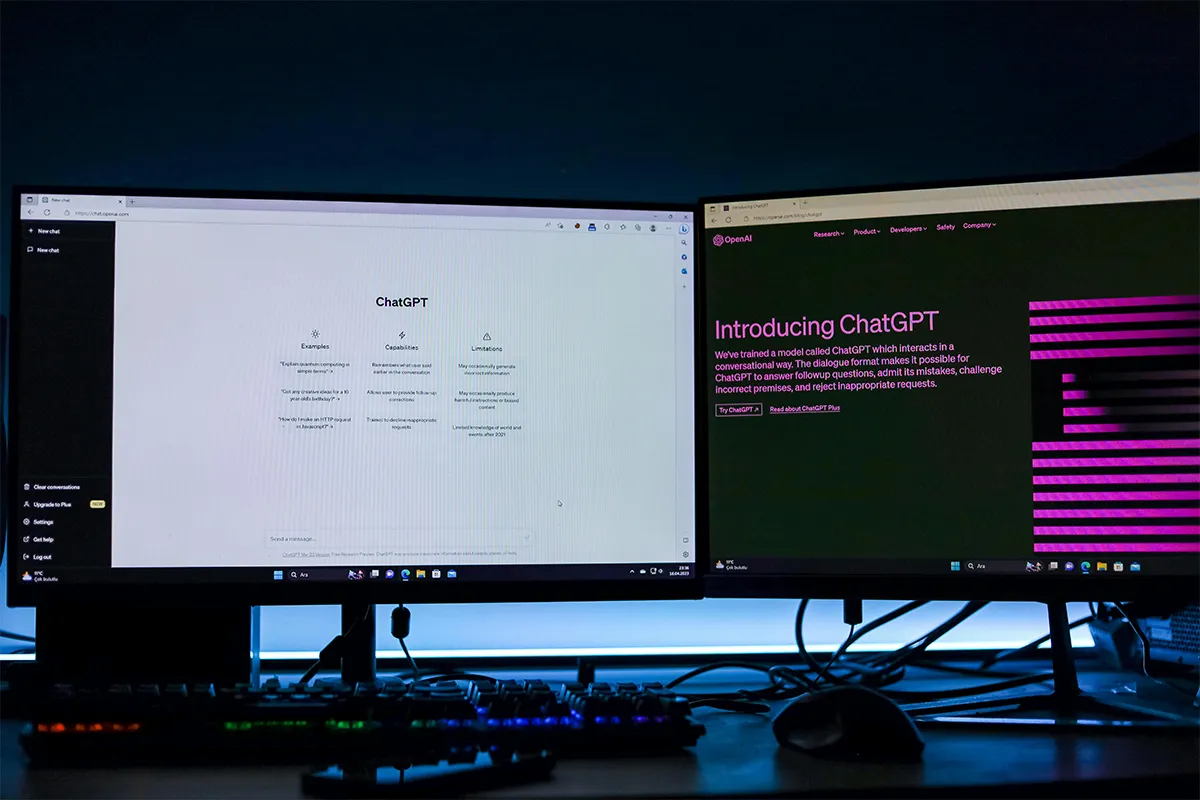The world of content writing and chatting has changed dramatically. It has become more efficient with the passage of time. Now, it is much easier to access AI chatting applications on your mobile phone. These applications are easily available to download from the Android Google Play Store and Apple Store. You do not have to be in front of your desktop. With chatbots, you can access advanced AI language models like ChatGPT-4o and Gemini Pro from your cell phone.
Mobile chatting applications make it easier to write blog posts, reply to emails, write letters, design resumes, cover letters, AI games, and much more from the palm of your hand. It is like a complete and advanced AI engine in your pocket. The question arises of how we can build a mobile phone chatbot using ChatGPT.
It is difficult to make one. However, the process becomes convenient when we use ChatGPT to make our own chatbot. ChatGPT gives you detailed guidance at every step of designing and completing your mobile chatting app.
Prerequisites
- OpenAI API Access: You need OpenAI API access to start making your ChatGPT mobile chatbot. First, you must get access to the OpenAI API. This API lets your bot chat like a human. You may have great ideas for your chatbot, but without the API, those ideas stay dreams.
- Programming Languages: Next, you need to choose a programming language. Python and JavaScript are popular languages. Python is good for beginners and strong for tasks like data handling. JavaScript is good for making mobile apps. Both languages have big communities and many resources. They help you learn better. Think about which language fits your style and needs more.
- Mobile Development Frameworks: Mobile development frameworks are also important for making apps. You should think about using Flutter or React Native. Flutter gives you nice user interfaces and works well for apps on different platforms. React Native lets you make apps using JavaScript. It combines web development and mobile power. Choosing the right framework saves you time and effort. It also makes your chatbot feel more real.
Installing Necessary Software
Now, you need to install the necessary software. First, you start with a code editor. Visual Studio Code is a good option. It is easy to use and has many helpful features. An editor helps you write and fix your code well.
After that, you install the SDKs for the mobile framework you chose. SDKs give you tools to build your app. Each framework has different steps for installation. You must follow the documentation closely, and you go on the right path.
Once you set up the software, you register for OpenAI API access. You go to the OpenAI website and create an account. This process is simple, but it is very important for your chatbot’s success. After you register, you get to make an API key. This key connects your app to the OpenAI services. You must keep it safe. It allows your chatbot to work. You will soon see your creative ideas come to life.
Designing the Chatbot
First, decide what your chatbot will do. You need to explore different use cases. Customer service chatbot is a common choice. Companies use chatbots to answer questions quickly. This saves time for both customers and employees. A personal assistant chatbot organizes tasks. It reminds users of important appointments. Chatbots can also entertain users. They tell jokes or share trivia. These use cases help shape your chatbot personality.
The next step is to design the conversation flow. You must think about user input situations. Consider what users will ask. Create a list of likely questions. Then, map out your bot responses. Each response should feel natural and friendly. Plan for different situations. Users might misspell words or ask in broken sentences. Prepare your chatbot to handle these errors. Offer clarifying questions to help users. This way, your chatbot becomes helpful. Users like a seamless experience.
Developing the Mobile Application
1. Create a New Project: Next, you need to set up your mobile project. Use the framework that you chose before. Create a new project and give it a good name. The name should reflect the chatbot’s purpose. The right name helps catch the attention of users. Configure project settings to fit your needs. This includes aspect ratios and compatibility for many devices. It helps your app look good everywhere.
2. Implementing the User Interface: A strong user interface makes a bot stand out. Start with the main chat screen. Keep it simple and clean. Users can easily send messages. Add necessary inputs and outputs. This allows users to type and see responses. Make sure the design is inviting. A friendly layout helps people talk to each other.
3. Integrating ChatGPT API: You need to integrate the ChatGPT API for good answers. Use the API to send messages from users. Capture user input correctly. Then, catch the replies from ChatGPT. Show these replies clearly on the screen. Users need to read replies easily. This API is a popular choice for virtual assistance.
4. Enhancing User Experience: You must make the user experience better. Add typing indicators. These show users what the bot is thinking. You should add voice-to-text functions. This feature lets users talk instead of type. It makes communication faster and more fun. A good experience keeps users coming back. They enjoy chatting with a friendly chatbot.

Testing the Chatbot
Testing is a very important step in making a mobile chatbot. Start with unit testing the components. Focus on individual parts of your chatbot first. You must ensure that each piece works well. Test the message input and the response from ChatGPT. One small mistake can cause big problems later. Make sure everything runs smoothly.
Next, do user acceptance testing. Invite real users to try your chatbot. They can give new views and insights. Watch how they talk with your chatbot. Take notes of any problems they have. This feedback is important for making improvements. You want your chatbot to be easy to use. If users find it confusing, they may not come back.
After you finish testing, gather feedback. Use surveys or talk directly to collect opinions. Ask users what they liked and what they think can be better. This information will guide your next steps. Do not be scared to ask difficult questions. Knowing user needs makes your chatbot better.
Deployment
When testing is done, it is time for deployment. Prepare to submit the app to the app store by following the rules. Each platform has its own guidelines. Research the requirements for both the Google Play Store and Apple App Store chatbots. Pay close attention to design and content restrictions. Not following these rules can delay or block your app launch.
Creating marketing materials for your app is another important step. Prepare engaging screenshots. Write good descriptions. Highlight the unique features of your chatbot. Capture the attention of potential users. Great marketing can help your app to stand out in crowded stores. Think about what makes your chatbot special. Showcase these features.
Finally, deploy your app on both platforms. Follow the submission process very carefully. Monitor feedback after the launch. Be ready to fix bugs. Be ready to make updates. An app goes through many changes after release. Users appreciate developers who listen. They appreciate developers who respond. Stay prepared for ongoing improvements. Your chatbot journey is just beginning.
Maintenance and Updates
Keep an eye on how users talk with your chatbot. This helps you to spot patterns. This helps you to understand what users enjoy. Use analytics tools to track messages and questions. Use analytics tools to check user satisfaction. Recognizing this data allows you to make choices. The better you know your users, the better your chatbot can help them.
Regular updates are key for improving your chatbot. Technology changes very quickly. User needs can shift over time. Schedule updates to fix bugs. Schedule updates to introduce new features. These changes keep your chatbot fresh. Changes make your chatbot engage. Users will appreciate knowing that you care about their experience. They will likely return more often if they see you make improvements.
User feedback is very valuable for refining your chatbot. Encourage users to share their thoughts. You can do this with surveys. You can ask direct questions at the end of a chat. Analyze this feedback to find common themes. Implement change based on real user input. This improves the chatbot. It also makes users feel valued.
Conclusion
Building a mobile chatbot with ChatGPT is a fun journey. First, you set your tools up. You design the conversation flow. You continue with development. You do testing steps to ensure quality. At last, you launch your chatbot. You monitor its performance. Regular maintenance and updates are critical for success.
You think about future improvements for your chatbot. Do you consider adding features like voice recognition? You also think about personalized responses. These ideas can make the user experience better. Technology evolves. It is important to stay ahead of trends.
You do not hesitate to try new ideas. Each change can lead to an unexpected success. You embrace creativity to shape your chatbot.
